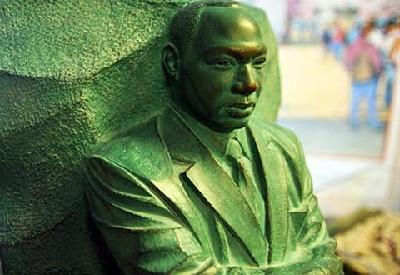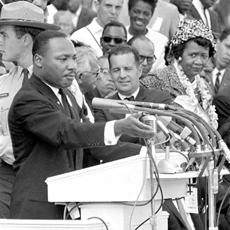
STEVE EMBER: Welcome to THIS IS AMERICA in VOA Special English. I'm Steve Ember.
FAITH LAPIDUS: And I'm Faith Lapidus. This week on our program, we tell you about a memorial being built in Washington to honor Martin Luther King Junior. He was America's most influential civil rights leader of the 20th century.
(MUSIC: "Oh Freedom"/Odetta)
STEVE EMBER: The third Monday in January is a federal holiday in the United States observing the birthday of Martin Luther King. The new memorial to the civil rights leader is set to open this August on the National Mall. The dedication ceremony is set for August 28th. That was the day in 1963 that he gave his "I Have a Dream" speech at the Lincoln Memorial.
MARTIN LUTHER KING: "Free at last, free at last. Thank God almighty we are free at last."
FAITH LAPIDUS: The memorial was 20 years in the planning. It will include a large statue of Martin Luther King. It will also include a wall of quotations from his writings and speeches.
HARRY JOHNSON: "And then you see that we have a crescent-shaped wall 700 feet long."
FAITH LAPIDUS: Harry Johnson heads the foundation that has been raising money for the project.
HARRY JOHNSON: "I think we are overjoyed here at the Memorial Foundation, knowing, understanding and believing that this is going to come to fruition, and that we are soon going to have a Martin Luther King Memorial here on our nation's Mall."
STEVE EMBER: In the 1960s, Martin Luther King led protests against racial discrimination. He taught nonviolence. He was influenced by the teachings of India's independence leader, Mohandas Gandhi.
Dr. King's efforts helped lead to the 1964 Civil Rights Act. That law barred discrimination based on race, sex, religion or national origin.
Martin Luther King was shot to death four years later, in 1968, in Memphis, Tennessee.
FAITH LAPIDUS: The new memorial will occupy land close to the Washington Monument and other memorials. President Obama has been invited to speak at the ceremony.
Martin Luther King will be honored with a statue ten meters tall. The memorial will also include the Mountain of Despair, a granite structure weighing 1,600 metric tons.
The lead sculptor for the memorial is Chinese artist Lei Yixin. Harry Johnson explains why the memorial foundation chose him for the project.
HARRY JOHNSON: "We chose him because we really believe that Dr. King's message is true, that you should not judge a person by the color of his skin but by the content of his character. In these terms, we are thinking artistic character."
STEVE EMBER: Mr. Johnson says the memorial will make a powerful statement about the progress the country has made in the area of civil rights.
HARRY JOHNSON: "If America was as prejudiced as they say, then would they ever put an African-American on the Mall? And the answer would be no. So now they say we have diversified. We have an America that looks like America when they look at the Mall. And I think visitors from around the world are going to say it is about time that you all, we all understand who Dr. King really was and what he means, not just to America, but indeed the world."
(MUSIC: "I Shall Not Be Moved"/Johnny Cash)
FAITH LAPIDUS: Martin Luther King's life as a civil rights leader began with the famous protest by Rosa Parks in 1959. The protest took place on a bus in the southern city of Montgomery, Alabama.
At that time, black people in Montgomery had to sit in the back of the bus. Rosa Parks took a seat near the front and refused to move. She was arrested.
STEVE EMBER: Such incidents had taken place before. Racial separation laws existed all over the southern states. Black people did not have the same rights as white people.
But this time a young black minister decided to organize a protest. Martin Luther King urged black people to boycott the buses in Montgomery. That protest marked the beginning of the civil rights movement in the United States.
FAITH LAPIDUS: Dr. King was born in Atlanta, Georgia, on January 15th, 1929. His father was a Baptist minister. His mother was a former schoolteacher.
He attended Morehouse College, one of the few colleges in the South open to blacks. He studied Gandhi and the works of the American philosopher Henry David Thoreau. He thought their ideas about nonviolence and disobedience could be used together to win equal rights for black Americans.
Gandhi believed in peacefully refusing to obey unjust laws. Thoreau urged people to be willing to go to prison for their beliefs.
STEVE EMBER: After college, Martin Luther King continued his studies in religion. He also met Coretta Scott, who became his wife. He earned a doctorate in religion, and in 1954 a church in Montgomery offered him a job.
Martin and Coretta King started a family and became involved in a number of activities to help the poor.
FAITH LAPIDUS: Many white people thought the Montgomery bus boycott would end if Dr. King was in prison or dead. He was arrested twice. His arrests made national news and he was released.
He continued to receive threats against his life. Finally, the United States Supreme Court ruled that racial separation in the Montgomery bus system was unconstitutional.
The boycott lasted 382 days. The victory gave black Americans a new feeling of pride and unity. They saw that peaceful protest could be used as a tool to win their legal rights.
The civil rights movement spread fast. A group of black churchmen formed an organization to guide it. Dr. King became president of this new group, the Southern Christian Leadership Conference. He helped organize many protests in the South.
STEVE EMBER: In 1963, blacks in Birmingham, Alabama, refused to buy goods from local stores. They demanded more jobs. They also demanded to send their children to white schools. The situation became tense. Many protesters were beaten and arrested.
The protests brought unwanted attention to Birmingham. Soon, white politicians saw that it was easier to meet the demands of the protesters than to fight them. That victory for Dr. King and his followers marked another turning point for the civil rights movement.
Shortly after that, Dr. King organized the March on Washington for Jobs and Freedom. About 250,000 people gathered in the capital. They heard Martin Luther King give his most famous speech. He talked about his dream for the future.

MARTIN LUTHER KING: "And so even though we face the difficulties of today and tomorrow, I still have a dream. It is a dream deeply rooted in the American dream.
"I have a dream that one day this nation will rise up and live out the true meaning of its creed: "We hold these truths to be self-evident, that all men are created equal.
"I have a dream that one day on the red hills of Georgia, the sons of former slaves and the sons of former slave owners will be able to sit down together at the table of brotherhood."
FAITH LAPIDUS: The following year, in 1964, Dr. King received the Nobel Peace Prize. After returning from the ceremony in Norway he led a voter registration campaign in Selma, Alabama.
Next he went north to Chicago, Illinois, to launch efforts to improve poor neighborhoods. But in the North he found that young blacks were not as interested in his methods of peaceful protest.
The civil rights leader turned his attention to other issues. His opposition to the Vietnam War cost him the support of white allies, including President Lyndon Johnson.
Dr. King also demanded a guaranteed income for American families as a way to fight poverty. He threatened to organize national boycotts.
STEVE EMBER: In 1968, Martin Luther King was planning to lead a Poor People's March on Washington. But he never made it. He had gone to Memphis, Tennessee, to lead protests that grew out of a strike by black sanitation workers.
The workers were demanding safer working conditions, higher pay and union representation. But a march led by Dr. King turned violent. Some of the demonstrators broke the windows of businesses and people then stole goods.
FAITH LAPIDUS: A week later, on April 4th, 1968, Dr. King was shot in the neck as he stood on the balcony of a Memphis motel.
James Earl Ray admitted in court that he shot Dr. King. Later, he declared that he was innocent. He died in prison in 1998.
Dr. King's murder incited violence in cities across the country. But that same year, Coretta Scott King established the Martin Luther King Junior Center for Nonviolent Social Change. The King Center in Atlanta serves as a "living memorial" to Dr. King.
And today the Lorraine Motel where he was shot is the home of the National Civil Rights Museum.
(MUSIC:"We Shall Overcome"/Joan Baez)
STEVE EMBER: Our program was written and produced by Brianna Blake, with reporting by Jeff Swicord. I'm Steve Ember.
FAITH LAPIDUS: And I'm Faith Lapidus. You can comment on our programs and find transcripts and MP3s at voaspecialenglish.com. You can also find a video about the new Martin Luther King memorial in Washington. And we're on Facebook and Twitter at VOA Learning English. Join us again next week for THIS IS AMERICA in VOA Special English.
crescent: a curved shape that is wide in the middle and pointed at each end 新月形;月牙形
granite: a type of hard grey stone, often used in building 花岗岩;花岗石
40th anniversary of Martin Luther King Jr's death
Obama honors Martin Luther King, Jr.
Obama's presidency a living example for African Americans
(来源:VOA 编辑:崔旭燕)
